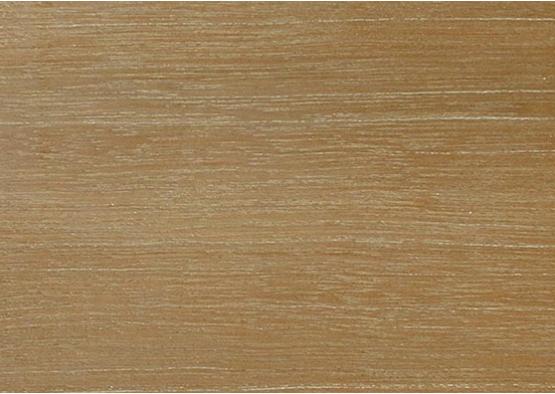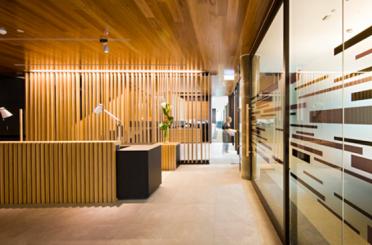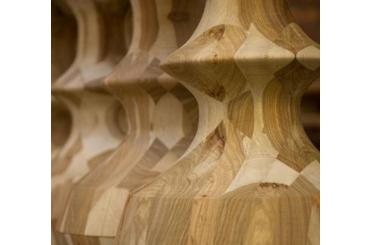Keruing is a hardwood native to South East Asia and used in a wide variety of internal and external applications.
Apitong, Hagakhak, Panau, Dau, Eng, Yang, Keruwing, Kruen, Kujun, Klalar, Keroewing, Iagan,Dipterocarpus, Dipterocarpus alatus, Dipterocarpus apterus, Dipterocarpus baudii, Dipterocarpus cornutus, Dipterocarpus costulatus, Dipterocarpus crinitus, Dipterocarpus dyeri, Dipterocarpus exalatus, Dipterocarpus gracilis, Dipterocarpus gradiflorus, Dipterocarpus indicus, Dipterocarpus lowii, Dipterocarpus macrocarpus, Dipterocarpus obtusifolius, Dipterocarpus sublamellatus, Dipterocarpus turbinaturs. Dipterocarpus verrucosus, Dipterocarpus warburgii
Dipterocarpus confertus

Keruing is the name given to the timber yielded from more than 70 species of the genus Dipterocarpus. This group of large hardwoods is indigenous to South East Asia, where the species are harvested from managed forests with regeneration programs.
Across the entire species, a wide variety of heartwood hues are available, including deep-pink, orange-pink and purple-red. The most common heartwood is red-brown. Sapwood is usually lighter, sometimes with yellow or grey tinges. The wood darkens with age and features a generally straight, or shallowly interlocked grain, sometimes with a stripe figure on the radial surface. Texture varies between species from fine to coarse but is always uniform.
Keruing timber is low maintenance, hardwearing and ideal for outdoor furniture use. The wood is strong and classified as durable, making it useful for construction purposes. Other common uses include internal flooring, protected framing and boards, internal joinery and mouldings, lining, paneling and framework. Preservative-treated material is used for poles, piles, sleepers and cross-arms. It is often used as a cheaper alternative to oak for heavy construction, decking, vehicle building and sleepers, and it is also in plywood.
Where other timbers may require curing, keruing is completely cured and ready for immediate use with no risk of leaching, bleeding or leach sap. It contains oleo-resins and will exude it onto surfaces during drying or when exposed to heat or sunshine when in use; gums may also cause problems in machining.
Shrinkage
| Very Low | Low | Medium | High | Very High | |
|---|---|---|---|---|---|

|

|
||||
Tangential : |
5.30%
|
||||
Radial : |
2.40%
|
||||
Unit Movement Tangential: |
0.53%
|
||||
Unit Movement Radial: |
0.24%
|
Strength Group

Very High |
High |
Reasonably High |
Medium High |
Medium |
Reasonably Low |
Low |
Very Low |
||
Unseasoned: |
S1 |
S2 |
S3 |
S4 |
S5 |
S6 |
S7 |
S8 |
|
|---|---|---|---|---|---|---|---|---|---|
 |
|||||||||
Seasoned: |
SD1 |
SD2 |
SD3 |
SD4 |
SD5 |
SD6 |
SD7 |
SD8 |
|
 |
Stress Grade

| Structural No. 1 |
Structural No. 2 |
Structural No. 3 |
Structural No. 4 |
Structural No. 5 |
|
Unseasoned: |
F17 |
F14 |
F11 |
F8 |
F7 |
Seasoned: |
F27 |
F22 |
F17 |
F14 |
F11 |
Density per Standard

Seasoned: |
780kg/m3
|
|---|---|
Unseasoned: |
950kg/m3
|
Joint Group

Very High |
High |
Reasonably High |
Medium |
Low |
Very Low |
|
Unseasoned: |
J1 |
J2 |
J3 |
J4 |
J5 |
J6 |
|---|---|---|---|---|---|---|
 |
||||||
Seasoned: |
JD1 |
JD2 |
JD3 |
JD4 |
JD5 |
JD6 |
 |
Colour

| White, yellow, pale straw to light brown | Pink to pink brown | Light to dark red | Brown, chocolate, mottled or streaky | |
 |
||||
Mechanical Properties
Modulus of Rupture - Unseasoned: |
82
|
|---|---|
Modulus of Rupture - Seasoned: |
137
|
Modulus of Elasticity - Unseasoned: |
12
|
Modulus of Elasticity - Seasoned: |
14
|
Maximum Crushing Strength - Unseasoned:  |
39
|
Maximum Crushing Strength - Seasoned: |
72
|
Impact - Unseasoned: |
|
Impact - Seasoned: |
|
Toughness - Unseasoned: |
Low - up to 15 Nm
|
Toughness - Seasoned: |
Low - up to 15 Nm
|
Hardness - Unseasoned: |
4.7
|
Hardness - Seasoned: |
5.6
|
Durability
| Low | Moderate | Reasonably High | High | |
| (0 - 5 yrs) | (5 - 15 yrs) | (15 - 25 yrs) | (more than 25 yrs) | |
In-Ground: |
 |
|||
| (0 - 7 yrs) | (7 - 15 yrs) | (15 - 40 yrs) | (More than 40 yrs) | |
Above ground: |
 |
|||
| (0 - 20 yrs, usually < 5) | (21 - 40 yrs) | (41 - 64 yrs) | (More than 60 yrs) | |
Marine Borer Resistance: |
 |
Lyctid Borer Susceptibility: |
Susceptible |
|---|---|
Lyctid Borer Susceptibility - Other: |
|
Termite Resistance: |
Not Resistant
|
Fire Properties
| 0 | 1 | 2 | 3 | 4 | 5 | 6 | 7 | 8 | 9 | 10 | |
EFH Spread-of-Flame Index: |
|||||||||||
EFH Smoke-Developed Index: |
| 1 - non-combustible | 2 - reasonably non-combustible | 3 - slightly combustible | 4 - combustible | |
Fire Properties Group |
Group Number - Other: |
3 if used on MDF or particleboard ≥12mm; veneer thickness 0.6-0.85mm
|
|---|---|
Average Specific Extinction Area: |
<250
|
Bushfire Resistance: |
BAL 12.5 and 19 – All AS3959 required applications
|
Across this entire species of keruing, a wide variety of heartwood hues are available, including deep-pink, orange-pink, and purple-red. The most common heartwood is red-brown. Sapwood is usually lighter, sometimes with yellow or grey tinges. The wood darkens with age and features a generally straight or shallowly interlocked grain, sometimes with a stripe figure on the radial surface. Texture varies between species from fine to coarse but is always uniform.
Keruing timber is strong and classified as durable, making it useful for construction purposes. Other common uses include internal flooring, protected framing and boards, internal joinery and mouldings, lining, paneling, and framework. Preservative-treated material is used for poles and piles.
Keruing may be difficult to work when dry due to the presence of both silica and resin. Sanding dust can irritate the skin. The wood nails satisfactorily but glues variably.
Where other timbers may require curing, keruing is completely cured and ready for immediate use with no risk of leaching, bleeding or leach sap. It contains oleo-resins and will exude it onto surfaces during drying or when exposed to heat or sunshine when in use; this high resin content makes it a poor base for coating. Gums may also cause problems in machining and it is unsuitable for steam bending.

Panelling, Interior

Mouldings
Allied Forest Products
Australian Timber

Authentic Gates Pty Ltd

Mathews Timber Pty Ltd


